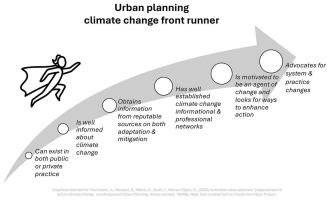澳大利亚城市规划者准备采取行动应对气候变化
IF 9.2
1区 环境科学与生态学
Q1 ECOLOGY
引用次数: 0
摘要
土地利用和开发模式对温室气体排放(GHG)和管理气候变化带来的风险具有重大影响。因此,城市规划者在应对气候变化方面发挥着关键作用,与景观设计师等不同的建筑环境参与者合作。然而,研究表明,虽然城市规划者了解气候变化,但他们自我感知的技能和能力有限。本文旨在了解澳大利亚城市规划者为应对气候变化(减少温室气体排放和适应气候变化影响)所做的准备。通过对23位不同的澳大利亚城市规划者的深度访谈,本文运用Moser和Luers的AAA气候变化准备理论探讨了应对气候变化的准备工作:气候变化意识;应对气候变化的分析能力;应对气候变化的行动。大多数受访者能够识别气候变化风险(意识)。气候变化风险的评估(分析能力)至少是通过洪水模型和其他风险评估提供信息的规划政策和工具进行的。在更进步的实践中,规划者利用内部或外部的气候变化专业知识,而不是规划系统工具。受访者为应对气候变化而采取的最常见的行动是在自己的组织内制定政策和战略——从政府工作人员制定的气候适应计划,到私营部门的组织可持续性计划。结果表明,城市规划系统有时是气候变化行动的推动者。由于规划工具,一部分受访者只接触到气候变化信息、分析能力和行动。制定了一个气候变化准备框架,展示了在答复国中观察到的从低到高准备情况的例子。本文确定了城市规划应对气候变化领跑者的特点,并提出了通过城市规划实践推进应对气候变化行动的方法。本文章由计算机程序翻译,如有差异,请以英文原文为准。

Australian urban planners’ preparedness to act on climate change
Land use and development patterns have a significant impact on greenhouse gas emissions (GHG), and on managing the risk that climate change poses. Thus, urban planners play a critical role in addressing climate change, working with diverse built environment actors such as landscape architects. However, research indicates that while urban planners know about climate change, their self-perceived skills and competence are limited. This paper seeks to understand the preparedness of Australian urban planners to act on climate change (both mitigating GHG emissions and adapting to climate change impacts). Through in-depth interviews with 23 diverse Australian urban planners, preparedness to act on climate change is explored using Moser and Luers’ AAA climate change preparedness theory: Awareness of climate change; Analytical capacity to address climate change; and Actions taken to address climate change. Most respondents were able to identify climate change risks (awareness). Climate change risks were being assessed (analytical capacity) at a minimum through planning policy and tools informed by flood modelling and other risk assessments. In more progressive practice, planners draw upon internal or external climate change expertise beyond the planning system tools. The most frequently stated action taken by respondents to address climate change was the development of policies and strategies within their own organisation – from development of climate adaptation plans by those working in government, to organisational sustainability plans for those in the private sector. Results indicate the urban planning system is at times a facilitator of climate change action. A proportion of respondents were only exposed to climate change information, analytical capacity and actions due to planning tools. A framework of climate change preparedness was developed, demonstrating examples of low to high preparedness observed across respondents. The paper identifies characteristics of urban planning cliamte change front-runners, and suggests ways to progress climate change action through urban planning practice.
求助全文
通过发布文献求助,成功后即可免费获取论文全文。
去求助
来源期刊

Landscape and Urban Planning
环境科学-生态学
CiteScore
15.20
自引率
6.60%
发文量
232
审稿时长
6 months
期刊介绍:
Landscape and Urban Planning is an international journal that aims to enhance our understanding of landscapes and promote sustainable solutions for landscape change. The journal focuses on landscapes as complex social-ecological systems that encompass various spatial and temporal dimensions. These landscapes possess aesthetic, natural, and cultural qualities that are valued by individuals in different ways, leading to actions that alter the landscape. With increasing urbanization and the need for ecological and cultural sensitivity at various scales, a multidisciplinary approach is necessary to comprehend and align social and ecological values for landscape sustainability. The journal believes that combining landscape science with planning and design can yield positive outcomes for both people and nature.
 求助内容:
求助内容: 应助结果提醒方式:
应助结果提醒方式:


